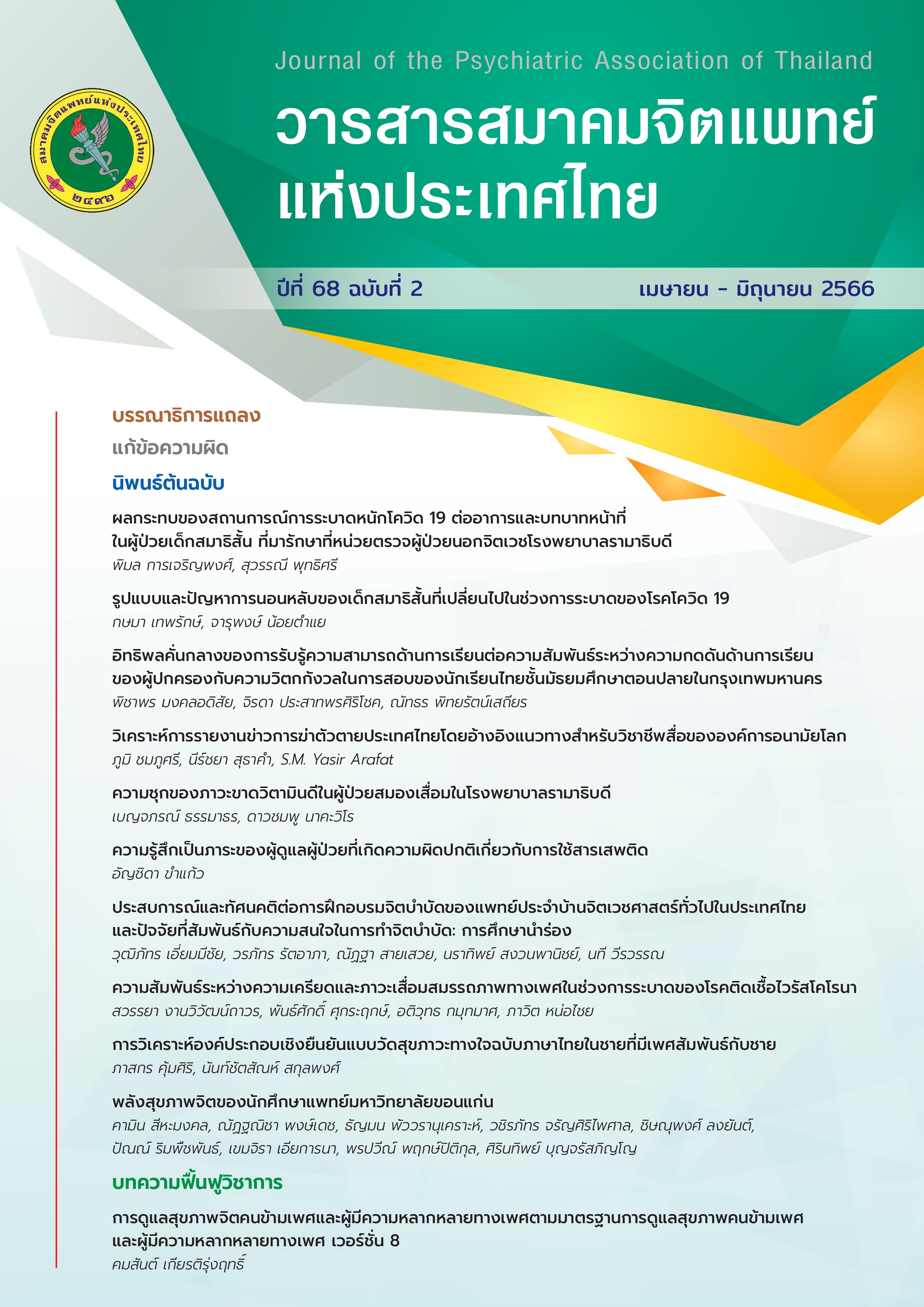ความสัมพันธ์ระหว่างความเครียดและภาวะเสื่อมสมรรถภาพทางเพศในช่วงการระบาดของโรคติดเชื้อไวรัสโคโรนา
Main Article Content
บทคัดย่อ
วัตถุประสงค์ เพื่อศึกษาความสัมพันธ์ระหว่างความเครียดและภาวะเสื่อมสมรรถภาพทางเพศในช่วงการระบาดของโรคติดเชื้อไวรัสโคโรนา
วิธีการศึกษา การศึกษานี้เป็นวิจัยเชิงพรรณนาแบบตัดขวาง กลุ่มตัวอย่างคือประชากรไทยที่มีอายุระหว่าง 20 - 59 ปี ทำการสำรวจโดยใช้แบบสอบถามออนไลน์ ใช้การสุ่มตามสะดวก (Convenience sampling) ดำเนินการสำรวจตั้งแต่วันที่ 15 - 17 มกราคม 2564 โดยใช้แบบประเมินและวิเคราะห์ความเครียด โรงพยาบาลสวนปรุง และแบบสอบถามประสบการณ์ทางเพศของมหาวิทยาลัยอาริโซนา ฉบับภาษาไทย วิเคราะห์ข้อมูลโดยใช้จำนวน ร้อยละ ค่าเฉลี่ย และทดสอบสมมติฐานด้วยการทดสอบ Chi-square test และ Binary logistic regression
ผลการศึกษา จากจำนวนผู้ตอบแบบสอบถามทั้งสิ้น 930 ราย ในช่วงการระบาดของ COVID-19 มีความชุกของความเครียดระดับมากและสูงมากถึงร้อยละ 65 ขณะที่ความชุกของภาวะเสื่อมสมรรถภาพทางเพศมีเพียงร้อยละ 2 ปัจจัยที่มีความสัมพันธ์กับความเครียด ได้แก่ เพศ อายุ รสนิยมทางเพศ ระดับการศึกษา โรคประจำตัว รายได้ และรายจ่าย อย่างมีนัยสำคัญทางสถิติที่ 0.1 ปัจจัยที่มีความสัมพันธ์กับภาวะเสื่อมสมรรถภาพทางเพศ อย่างมีนัยสำคัญทางสถิติที่ 0.10 ได้แก่ เพศ สถานภาพสมรส และระดับความเครียด นอกจากนี้ ยังพบว่า ผู้ที่มีความเครียดระดับมากและสูงมากมีโอกาสเสื่อมสมรรถภาพทางเพศได้สูงกว่าผู้ที่มีระดับ ความเครียดปกติ 1.086 เท่า โดยใช้ Binary logistic regression, OR = 1.086 (95% CI = 0.404-2.922)
สรุป COVID-19 มีการระบาดทั่วโลก แต่การศึกษาเกี่ยวกับความเครียดและภาวะเสื่อมสมรรถภาพทางเพศในประเทศไทยยังมีอย่างจำกัด การระบาดของ COVID-19 กระทบทั้งระบบสุขภาพ ภาคธุรกิจและสังคม ส่งผลให้เกิดความเครียดและภาวะเสื่อมสมรรถภาพทางเพศได้ การดูแลจึงควรครอบคลุมทุกด้านดังกล่าวนี้ด้วย
Article Details

อนุญาตภายใต้เงื่อนไข Creative Commons Attribution-NonCommercial-NoDerivatives 4.0 International License.
บทความที่ส่งมาเพื่อพิจารณา ต้องไม่เคยตีพิมพ์หรือได้รับการตอบรับให้ตีพิมพ์ในวารสารฉบับอื่น และต้องไม่อยู่ระหว่างการส่งไปพิจารณาในวารสารอื่น
เอกสารอ้างอิง
WHO.Coronavirus disease 2019 (COVID-19) [Internet];2020 [cited 2020 May 10]. Available from: https://www.who.int/docs/ default-source/coronaviruse/situation-reports/20200311- sitrep-51-covid-19.pdf?sfvrsn¼1ba62e57_10.
Thai PBS news. COVID-19 epidemic situation[Internet]; 2020 [cited 2020 May 10]. Available from: https://news.thaipbs.or.th/search?q=%E0%B9%82%E0%B8%84%E0%B8%A7%E0%B8%B4%E0%B8%94-19
Duan L, Zhu G. Psychological intervention for people affected by the COVID-19 epidemic. Lancet Psychiatry 2020;7:300-2.
Zhang J, Wu J, Li Y, Zhou Y, Zhao R, Shi Y, Chen J, et al. Influence factors of sexual activity for internal migrants in China. Sex Med 2018;6:97-107.
Li W, Li G, Xin C, Wang Y, Yang S. Challenges in the practice of sexual medicine in the time of COVID-19 in China. J Sex Med 2020;17:1225-8.
Butler L. Challenges in the practice of sexual medicine in the time of COVID-19 in the United Kingdom. J Sex Med 2020;17(7):1229-36.
Schiavi MC, Spina V, Zullo MA, Luffarelli P, Rago R, Palazzetti P. Love in the time of COVID-19: Sexual function and quality of life analysis during the social distancing measures in a group of Italian reproductive-age women. J Sex Med 2020;17:1407-13.
Ebrahim S. Sexual intercourse and risk of ischemic stroke and coronary heart disease: the Caerphilly study. J Epidemiol Community Health 2002;56(2):99-102.
Wright H, Jenks RA. Sex on the Brain! Associations between sexual activity and cognitive function in older age. Age Ageing 2016;45(3):313-7.
Lê MG, Bachelot A, Hill C. Characteristics of reproductive life and risk of breast cancer in a case-control study of young nulliparous women. J Clin Epidemiol 1989;42(12):1227-33.
Krejcie RV, Morgan DW. Determining sample size for research activities. Educational and Psychological Measurement 1970;30:607-10.
Mustafa N. Psychological stress and associated factors during the coronavirus disease (COVID-19). Int J Sci Res 2020;10(4):12-18.
Lai J, Ma S, Wang Y, Liu Z, Hu S, Kang L, Lai J, et al. Factors associated with mental health outcomes among health care workers exposed to coronavirus disease 2019. JAMA Netw Open 2020;3(3):e203976.
Czeisler MÉ, Lane RI, Petrosky E. Mental health substance use and suicidal ideation during the COVID-19 pandemic — United States, June 24–30, 2020. MMWR Morb Mortal Wkly Rep 2020;69:1049–57.
Kongkanand A. Prevalence of erectile dysfunction in Thailand. Thai Erectile Dysfunction Epidemiological Study Group. International Journal of Andrology 2000;23(2):77-80.
Hatzimouratidis K. Guidelines on male sexual dysfunction: Erectile dysfunction and premature ejaculation. European Urology 2010;57(5):804-14.
New York Post. COVID-19's latest side effect hits below the belt [Internet]; 2020 [cited 2020 May 10]. Available from: https://nypost.com/tag/erectile-dysfunction/.
Pennanen-Iire C, Prereira-Lourenço M, Padoa A. Sexual health implications of COVID-19 pandemic. Sex Med Rev 2021;9:3-14.
Galanakis M, Kallianta KC, Liakopoulou D, Chrousoes G. The association between stress and sexual dysfunctionality in men and women: A Systematic Review. Psychology 2021;6:1888-92.
Huang C, Huang L, Wang Y, Li Y, Zhong J, Cao B, Zhang D, et al. 6-month consequences of COVID-19 in patients discharged from hospital: a cohort study. Lancet 2021;391:220-32.
Yafi FA, Jenkis L, Albersen M, Corona G, Goldfarb S, Parish S, Salonia A, et al. Erectile dysfunction. Nat Rev Dis Primers 2016;2:16003.
Mori T, Hotta Y, Nakamura D, Yahagi R, Kataoka T, Maeda Y, Kimura K. The mechanisms of stress-induced erectile dysfunction: a focus on regulators of contraction and relaxation in the corpus cavernosum by using a rat model of water immersion-restraint stress. J Sex Med 2018;15(7):S139.


